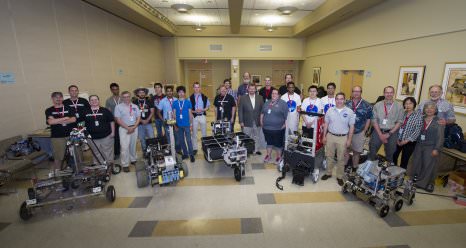Caption: Participants in NASA’s Sample Return Robot Challenge. Credit: NASA
Editor’s note: This guest post was written by Andy Tomaswick, an electrical engineer who follows space science and technology.
Picking up rocks can be harder than you’d think. That is one of the lessons to take away from the recently completed Sample Return Robot Challenge hosted by NASA and the Worchester Polytechnic Institute (WPI).
The challenge offered a $1.5 million prize to the robot that could complete a series of automated search and retrieve missions while also meeting NASA’s technical standards for the design of the robot. NASA intended to farm the technologies developed for the competition for design ideas for a possible future Mars sample return mission.
Many NASA employees got to see the technologies first hand at the competition in Massachusetts on a weekend in June. Lori Garver, NASA’s deputy administrator, spoke at a pre-event ceremony followed by a chance for the teams to show off their robots to local high school students, with some 7,000 people in total attending the event.
The actual challenge started off with a test to see if the teams complied with the design regulations handed out by NASA. Five of the six teams that showed up for he event failed to meet the standards, with Team SpacePRIDE from Graniteville, South Carolina the only team to successfully do so. The main difficulty for most teams dealt with a safety-related pause switch which required all moving parts to immediately suspend its movement upon triggering that switch. This would, in theory, save any innocent bystanders from the wrath of an autonomous robot that is not yet subject to the Three Laws of Robotics. Despite the switch not functioning as intended on most robots, all the teams were allowed to participate in the actual event, and the competition went on as planned.
However, the task proved too much for any robot, as none were able to successfully collect the samples needed to meet the challenge’s requirements in the time allotted. The teams did display one of the strengths of the open challenge type format: they all brought very unique ideas to bear on solving the automated problem. Team SpacePRIDE drew particular attention by having a three-robot system, with two smaller scout rovers and one larger collector rover. All of the teams had plenty of feedback to give to the NASA sponsors, and all of the competitors seemed to enjoy themselves as well.
That feedback lies at the real heart of the Centennial Challenge competitions that NASA has been hosting. Even if no one wins the prizes on offer, the challenges themselves draw interest from students around the country as well as spawn ideas from the teams. The good thing about no one completing the challenge this year is that next year the $1.5 million pot is still up for grabs, assuming NASA agrees to sponsor the event again.
Source: NASA Sample Return Robot Challenge Concludes, Team SpacePRIDE


Maybe I’m missing something, but what exactly is the point of an emergency stop button on a Mars rover? Is that just in case there is a Martian that jumps out in front of the vehicle intent on filing a lawsuit against NASA for running it over, and demanding that NASA pays it’s hospital fees, and put it’s kids through Mars University?
For right now, I think NASA only has to worried about being sued by Earthlings; that’s the reason they had the switch requirement in the first place. Since these robots were autonomous, they weren’t necessarily restricted to the test field provided for them on WPI’s campus. The switch was needed so that if one of them decided to go out of the test field’s bounds (perhaps near an on-looking Earthling?), noone would get hurt in the process and NASA wouldn’t have to pay anybody’s college tuition.
What would REALLY be cool is a Europa sample return mission. Just drop a probe down onto Europa, scrape up some of that reddish-brown ice, and bring it back to Earth.
The nice thing about a mission to Europa is that you’d be able to pick up samples almost anywhere. Specifically what these robots were looking to do was collect the equivalent of rocks out of an environment where they only sort of stand out, hence some rather difficult pattern recognition software that had to be developed for this challenge. It does make one think about how many different places we could use technology like this though.